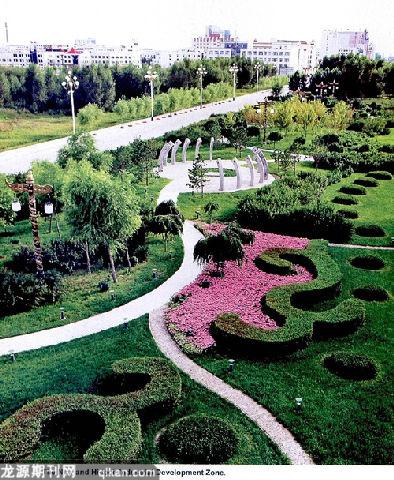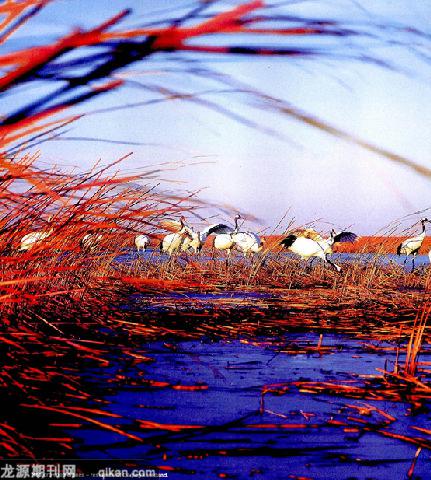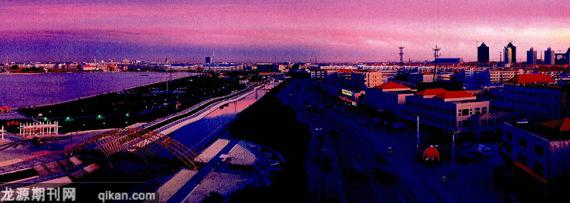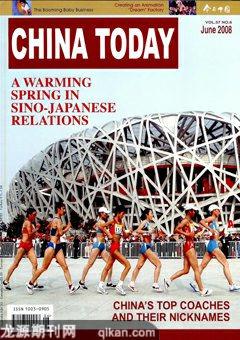Beyond Oil:The Example of Daqing
XU YING
DAQING, in northeast Chinas Heilongjiang Province, first emerged from the wilderness 49 years ago when drilling began in the regions 5,000-square-kilometer oil field, Chinas largest. After many boom years, however, the city has finally reached the point when it must begin questioning seriously the sustainability of its social and economic development models, as its oil, however abundant, cannot gush forever.

Diversifying the Economy
All non-renewable resources are finite, and all resource-based economies must face the day when their principal source of revenue runs dry. But Da- qing has been feeling the pinch even before then. Following a government decision to cut back Chinas oil output, the city began to feel the pressure on its resources, industries, ecology and employment.
“Daqing was an absolutely resource-dependant city. With our oil production in its middle or late phase, we have no hope if we dont foster other industries. Sustainable development not only has economic and social, but also political significance for us,” said Han Xuejian, the citys Party Secretary.
Han, formerly deputy mayor and mayor of Daqing before taking his current post, admitted that the issue of sustainable development was always at the back of his mind. He was delighted when reading a report by the citys expert consulting board which suggested overhauling and optimizing the local economy by developing continuous industries, such as petrochemicals and new- and hi-tech.
The opportunity soon arose to put those ideas into practice. In March 2005, Heilongjiang Province launched a program to build the Harbin-Daqing-Qiqihar Industrial Corridor as a way of jumpstarting a sustainable economy. And in May 2005, Daqing was selected by the State Council as one of Chinas oil-dependent cities slated for the economic transformation experiment, which has as its goal an accelerated program of industrial development, integration into the regional economy, and an environmentally friendly growth strategy.

For its section of the corridor, the municipal government of Daqing has given priority to the petrochemical, agricultural products processing, machine building, textiles, new building materials, electronics and information industries. It anticipates annual sales of RMB 100 billion or more from petrochemicals, and RMB 10 billion from each of the other five sectors.
Located between Harbin and Qiqihar, Daqing is the pivotal section of the corridor, linking the three cities. Its portion of the corridor is scheduled to reach 340.86 square kilometers and consist of 10 programs, including the Daqing New and Hi-tech Industrial Development Zone. It is expected to be a seedbed for non-oil industries and products at the higher end of the industrial chain, and the city hopes to expand its industrial sector, foster industrial clusters, optimize the pattern of economic growth and renovate the industrial structure. To that end, the zone has implemented a modern managerial mechanism, introduced new cutting-edge technologies, oriented the zone toward exports and promoted environmental conservation.
The Daqing New and Hi-tech Industrial Development Zone now accounts for half of the citys industry, and is considered the guarantor of the citys future. Approximately 2,000 enterprises now operate in the zone.
So far, the new- and hi-tech zone has demonstrated strong growth in six sectors – oil and petrochemicals, new materials, electronics and information, deep processing of agricultural and animal products, machine building and pharmaceuticals. From 2005 to early 2008, the 10 industrial programs of Daqing have launched 405 projects, with 297 now in operation. They are spread out over 36 square kilometers, with a total investment of RMB 28.75 billion.
Turning the Oil Field Green
Oil exploration is by nature antagonistic to environmental conservation. But that does not mean efforts to achieve a modicum of balance are hopeless. In that regard, Daqing Oil Field stands as an encouraging example. Looking out of the control center tower high above the Daqing Oil Field Company, one is amazed by the three-million-square-meter eco-park below, which encompasses millions of trees, winding streams, glittering pools, ornate bridges and Asias largest musical fountain. Such amenities are rare at oil producing sites.

People who visited the company years ago might not recognize it now. After part of the No.1 Oil Extraction Plant was demolished, more than 20,000 trees were planted on the vacant lot. The roads in the oil fields of No.2 Oil Extraction Plant were once lined by stagnant ditches. They are now densely carpeted with greenery and the water runs clear. The eastern and western ends of the No.4 Oil Extraction Plant used to be scarred by sumps and dumps. They now bloom with fragrant flowers and trees. And a green campaign is underway in the No.5 Oil Extraction Plant to rehabilitate its water and green spaces, and to implement a program of resource renewal and recycling.
These are the results of the steadfast efforts and generous inputs made by the company over the past few years. In 2007 alone, the company invested more than RMB 700 million on wastewater treatment, renovation of substandard oil storage pools, leveling ground and forestation. Of that sum, RMB 545 million went on addressing 12 categories of project security risks, constructing a sewage bio-chemical treatment station, building 166 emergency pools meeting national environmental standards, upgrading 8,954 substandard oil storage pools, renovating 80 well sites, clearing 23 sewage outlets, leveling 1.2 million square meters of land and planting 1.5 million trees. The remaining RMB 170 million was spent on construction of the Changyuan Plant for Treatment of Oil-containing Wastewater, whose daily capacity is 30,000 cubic meters. The project cut the chemical oxygen demand in the companys wastewater discharge by 20 percent.
After taking from Mother Nature for decades, Daqing is conscientiously repaying her kindness, and gains substantially by doing so.
A Wetland Treasure Trove
It is little known by people outside Daqing that the city has another precious resource aside from oil: 1.2 million hectares of wetland, which accounts for approximately 60 percent of the citys territory. There are some 573 million hectares of wetland on Earth, with 38.48 million hectares in China, the fourth-largest share in the world, and the largest in Asia. Daqing accounts for 3.12 percent of the nations total.
In physical geography, a wetland is an environment at the interface between truly terrestrial ecosystems and aquatic systems, making it inherently different from the others, yet highly dependent on both. It is one of the three major ecosystems on Earth, together with oceans and forests, and has beendubbed “natures kidney.”
There are 16 types of wetland in Daqing, which belong to six categories – marsh, salt marsh, wet meadow, lake wetland, river wetland and artificial wetland. They are home to 509 species of wild plants, 273 breeds of wild land animals, 45 species of fish and seven species of amphibians. Of all of Chinas wetland, the Longfeng (Dragon and Phoenix) Wetland is the only one located in a downtown area. It is a rare bucolic scene of graceful fowl and swaying reeds in a bustling cityscape.

Daqing values its wetland resources as much as it does its oil wealth. So far, it has set up six wetland reserves, including the provincial-level Longfeng Wetland and the national-level Zhalong Wetland (57 percent of which lies in Daqing).
Wetland can be a tourist magnet, and a significant source of revenue. With that in mind, Daqing will launch the first Wetland Culture Festival in mid-June, in the wake of the annual Harbin International Fair for Trade and Economic Cooperation, to advertise its unique gifts to the world. Accompanying the festival will be a number of forums themed on various topics, including equipment manufacturing, the chemical industry and hi-tech. The event will introduce visitors not only to Daqings natural beauty, but to its business opportunities as well.
People-centered
Modernization
Daqing underwent several shifts in urban planning in its history. It was exclusively a mining site in its early years. After Deng Xiaoping issued his instruction to “build a beautiful Daqing Oil Field” in 1979,the city embarked on an urbanization process. In 1985, the city worked out its first urban construction plan, which called for converting the urban structure from dispersed to concentrated. In the 1990s,Daqing considered building a modern city of science and technology. In the new century, it put forward a greater ambition: to become a regional center, a renowned oil city with multiple industries and a green urban landscape to draw tourists.
For a number of years, Daqings annual input on urban construction has exceeded RMB 10 billion, and annual housing construction stays above four million square meters. Among the most prominent projects are the bypass road of National Highway 301, Zhongsan Road, Sada Road, 20-odd railway viaducts and cloverleaf junctions, and the as yet unfinished Sartu Airport. A 3-D network of modern transport is taking shape.
In addition, the city launched a raft of programs of immediate concern to peoples daily lives, including the construction of a youth center for sci-tech activities, an educational and cultural center, and several residential areas, including the 140,000-square-meter Liminyuan neighborhood tailored to immigrants.
Daqings people have always kept the environment in mind while making these geographic alterations. Massive campaigns have been conducted to clear the water and air, and to convert farmland into forests and meadows. In 2001, Daqing was selected the mainlands first model city for environmental protection.

Since then it has received additional honors, including the Dubai International Award for Best Practices to Improve the Living Environment, the Chinese Prize for Human Habitat Environment, selection as one of the 2006 Top Ten Charming Cities, and the National Model City of Environmental Protection award, a title conferred by the State Administration of Environmental Protection in February 2008.
These achievements bode well for a reconciliation between nature and human activity, without putting a brake on progress.
A Well-off Countryside
While Daqings industrial sector and downtown area are booming, noted changes are also underway in its countryside. When Daqing was apportioned four counties – Lindian, Dorbod, Zhaozhou and Zhaoyuan – from two neighboring regions in the early 1990s, three were impoverished, two were of national level, and one of provincial. They augmented Daqings territory, but at the same time imposed a drag on its economy.
“Daqing cannot build a truly and completely modernized and well-off society without a modernized and well-off countryside,” said Han Xuejian. “The benefits of Daqings development must be shared by its rural population.”
These are not just empty words. In 2004, two years before the central government launched its campaign called “building a new socialist countryside,” Daqing unveiled a strategy for its agriculture, rural areas and farmers.
06
The move soon bore fruit. Jiang Wenzhu, a farmer in Hongwei Town of Lindian County, was the first beneficiary of the citys new cooperative medical care system for rural areas. He paid the premium of RMB 12 in September, 2004. One month later, he was hospitalized, and had RMB 7,090 of his expenses reimbursed. Today, the system covers 94.8 percent of Daqings rural population, and has paid RMB 29 million in indemnification to 310,000 farmers. The municipal and county/district governments earmark a special fund of RMB 50 million for its operation.
Since 2003, the municipal government has spent hundreds of millions of yuan to dig more than 110,000 wells, which protect 40 percent of local farmland from drought. The effect was immediate and noticeable. Despite a severe drought in 2007, the citys crop yield turned out to be close to 80 percent of its average harvest.
In recent years, Daqing has paved more than 4,600 kilometers of roads in its countryside, and extended the road network to every one of its 485 administrative villages. It also plans to build a first-grade highway or expressway between the downtown area to each of its counties, and second-grade highways between the counties. When completed, the drive between downtown and any of the counties will be cut down to two hours.
As the soaring price of fuel bites into economic gains worldwide, Daqings farmers have avoided the worst thanks to the citys provision on green energy. Daqing has been encouraging the use of methane among its rural residents, and building free methane cellars for them. In 2007 alone, the green gas found its way into 8,000 rural households. A villager in Linyuan Town said he was elated that his kitchen was now clear of the open flames and choking smoke he had to contend with when he burned wood chips and straw to cook.
Meanwhile, local farmers have been encouraged to take on the more lucrative livestock business. Daqing now keeps a cattle stock of 317,000 head, one of the largest in the nation. And its livestock sector rose to 54 percent of its rural economy, at RMB 2.13 billion.
Daqings mighty oil and petrochemical industries have also provided a shot in the arm for the countryside. To date, oil companies have opened 13 cooperative development zones in Daqings four counties, generating an annual income of RMB 600 million. In 2007, Zhaoyuan, Zhaozhou and Dorbod were listed among the top 10 counties with the largest revenue in Heilongjiang Province, with Zhaoyuan ranking first.
The phrase “building a new socialist countryside” is not perceived as obscure or abstract by Daqings rural residents, as it is the source of the steady, tangible improvements they see in their lives.

Heritage of the Iron Man
Wang Jinxi (1923-1970), an oil worker in Daqing, was a national icon in the 1950s and 1960s, and is still widely remembered today. After begging in the street with his blind father as a toddler, herding cattle for a landlord at 10, and toiling in a mine since 15, Wang showed heartfelt love and loyalty to the Peoples Republic after its founding in 1949, and devoted himself to his oil drilling job in Daqing. Intrepid and committed to his work and country, he was hailed as the Iron Man by his compatriots.
The Iron Mans spirit has been kept alive to this day. Monuments, museums and associations have been established in his honor, and awards are distributed in his name to model workers. He was held up as a beacon of hope and courage during the emergencies the city endured, including floods, earthquakes, snow disasters and epidemics.
On the night of March 27, 2005, an unprecedented snowstorm hit the Daqing Oil Field, disrupting the power supply and paralyzing road transport. Local oil workers and cadres were at their posts as early as 3 oclock the next morning. With a concerted effort by 20,000 employees, the more than 20,000 wells in the field damaged by the disaster were back in production within 79 hours.
With such cohesion and dedication, Daqings people are confident their city will survive and flourish with or without its oil wealth.

